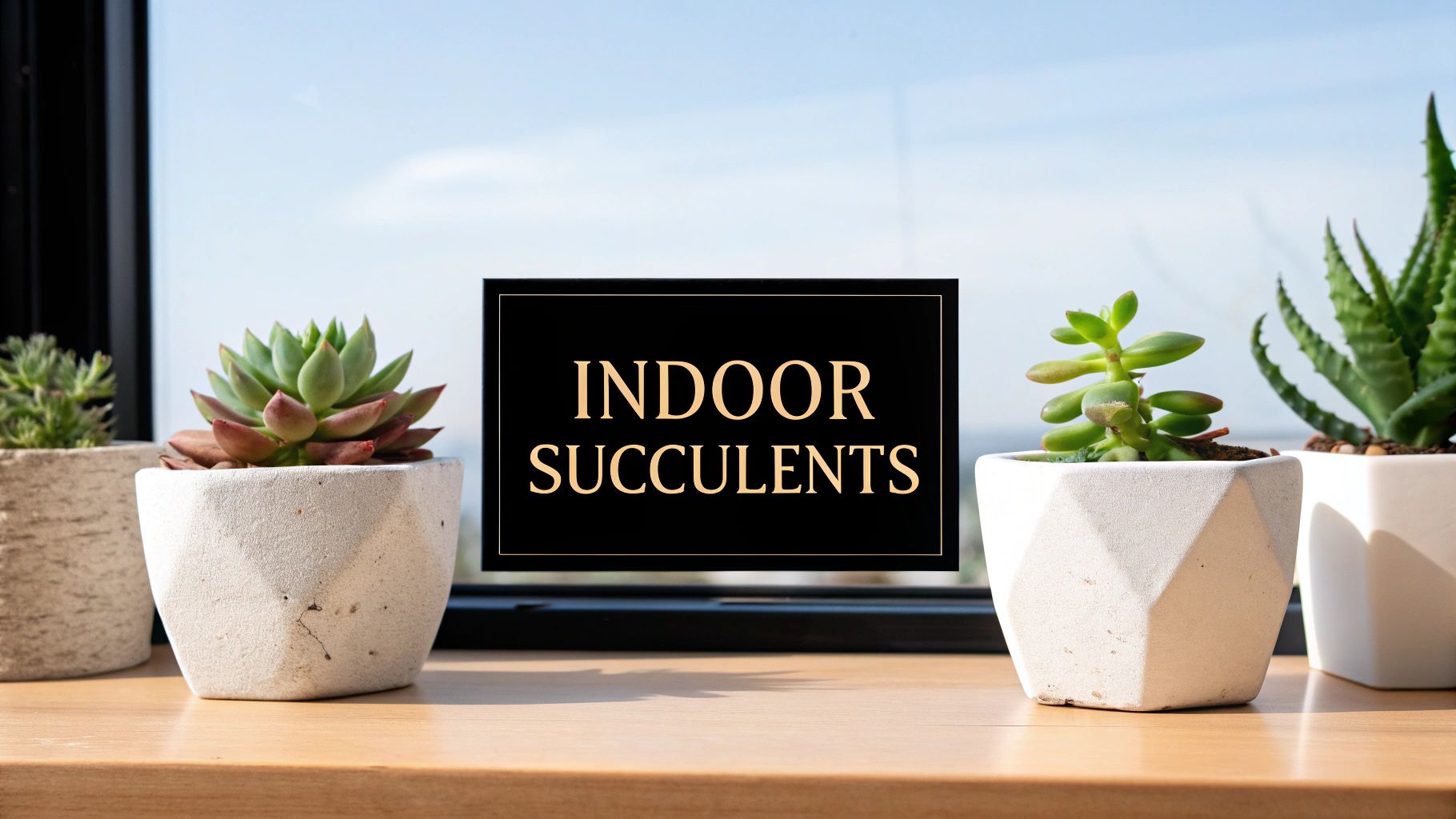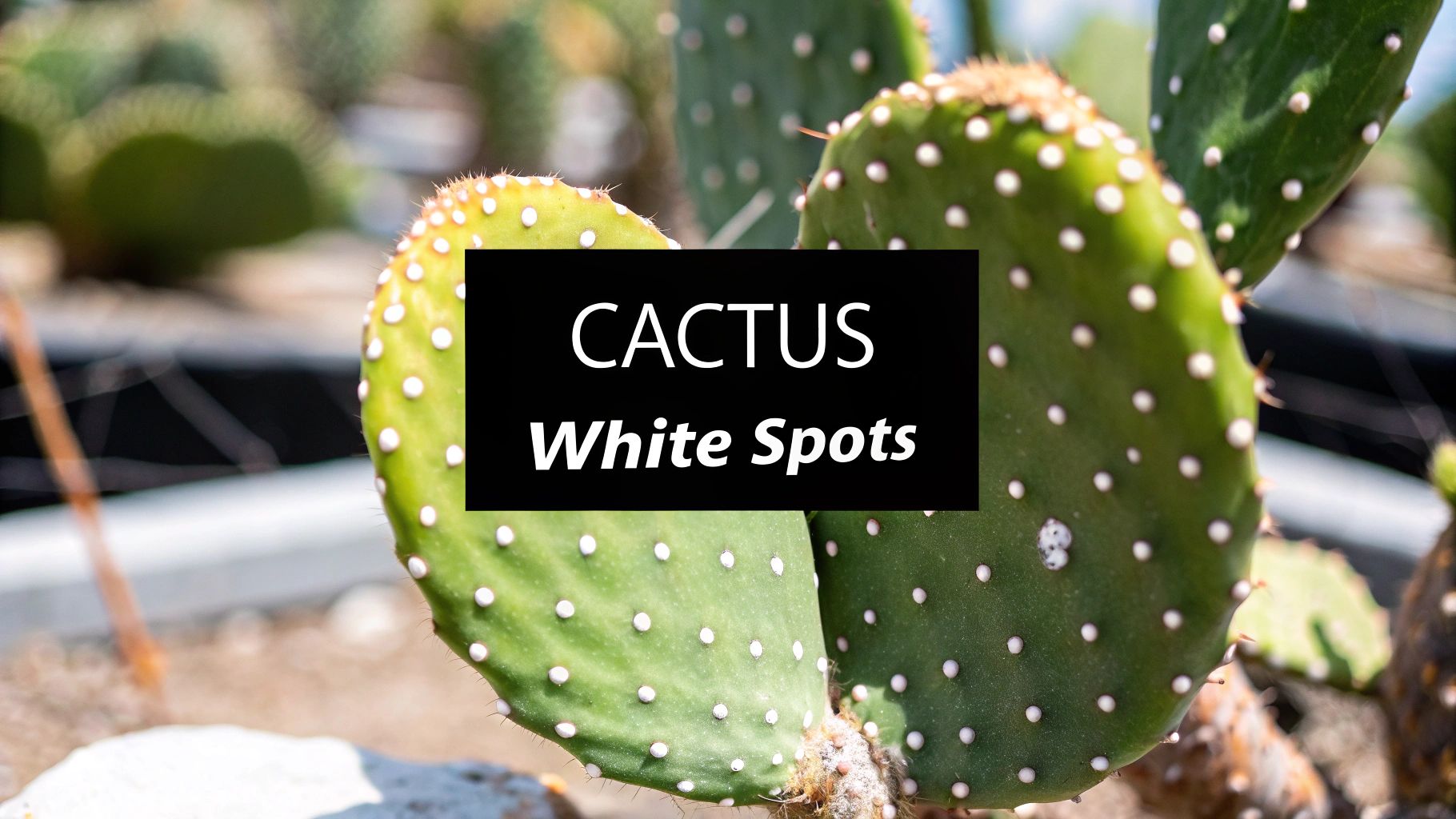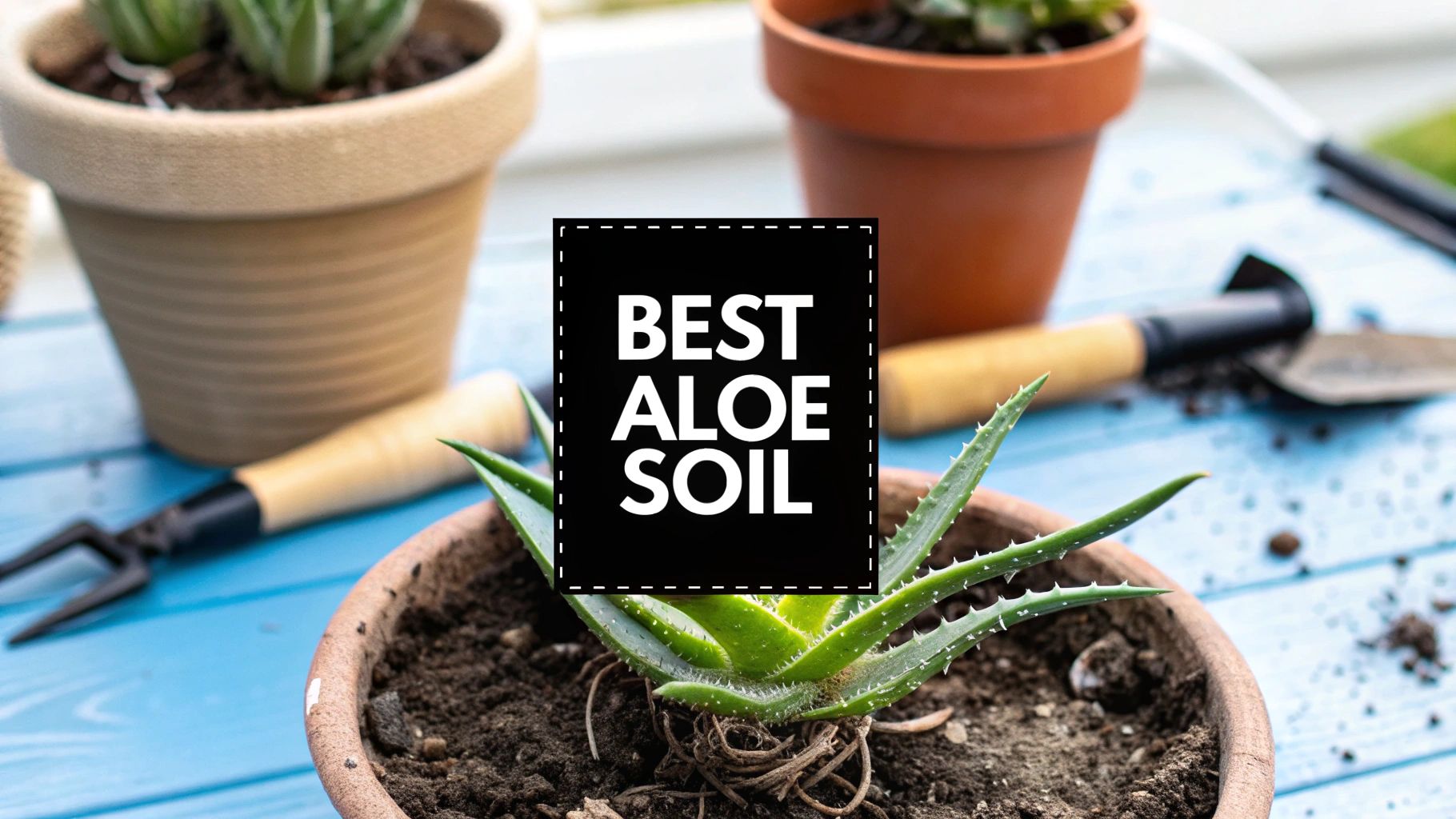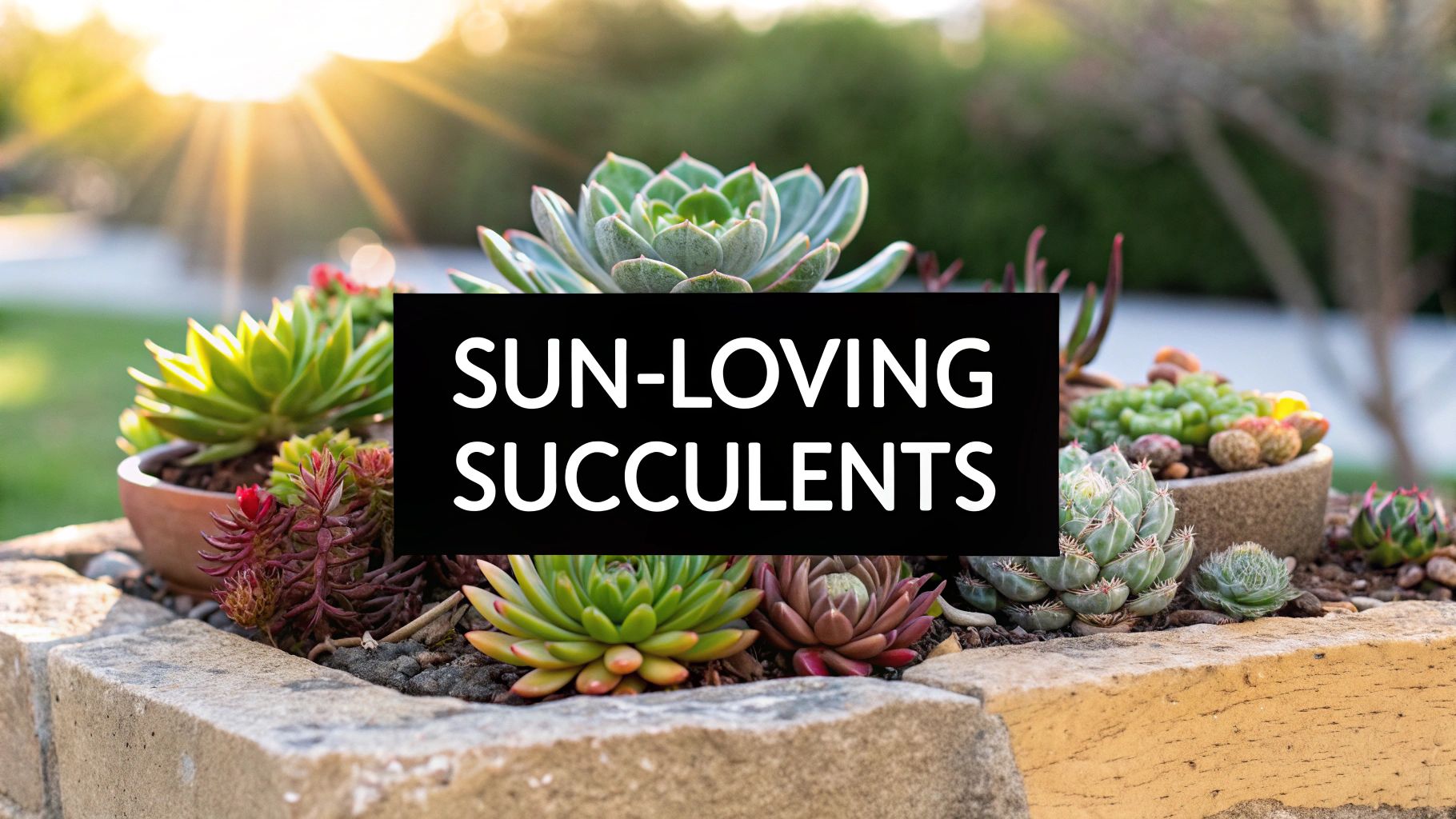When most people think of succulents, they often picture a single type of plant. The reality is, "succulent" isn't one big plant family but a massive, diverse group defined by a single superpower: the ability to store water in their leaves, stems, or roots.
This group includes everything from nearly indestructible snake plants to the brilliantly colored rosettes of sun-loving Echeverias. Finding the right one isn't about picking the prettiest; it's about matching a plant to your home's unique environment.
Welcome to the World of Indoor Succulents
Diving into the world of indoor succulents is like opening the door to a secret garden, one filled with fascinating living sculptures. These plants are anything but uniform, offering a stunning variety of shapes, colors, and textures. What ties them all together is that remarkable water-storing ability, which is exactly why they're so resilient and famously forgiving for beginners.
But their appeal goes way beyond being easy to care for. Bringing succulents into your home is a simple way to create a calmer, more natural living space. Their popularity has exploded, with the global succulent plant market projected to hit $5.08 billion in 2025 and continue its climb. You can dive deeper into the numbers by reading the full research about the succulent market.
Finding Your Perfect Plant Partner
Think of this guide as your personal plant matchmaker. We'll walk you through the different categories to help you find a succulent that fits your home and lifestyle perfectly. To get started, this decision tree is a great visual tool for narrowing things down based on your light conditions and how often you remember to water.
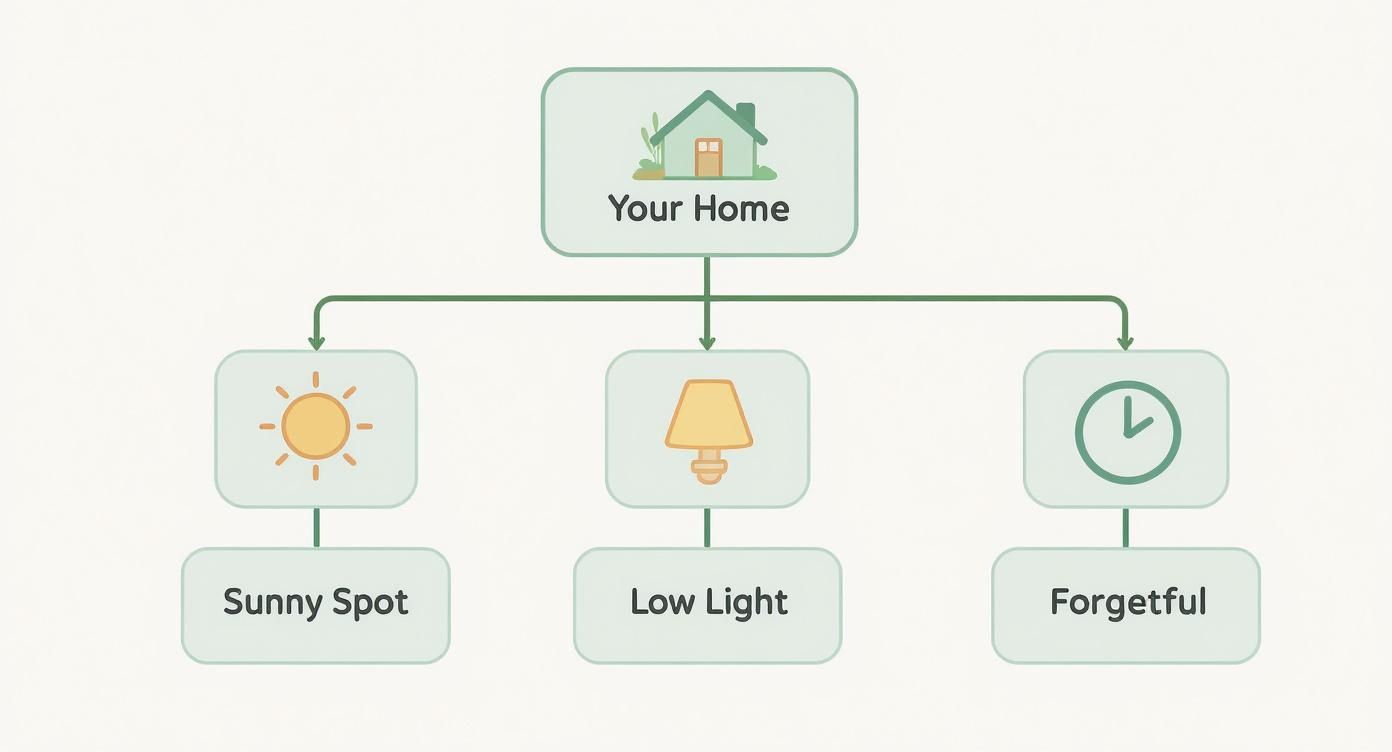
As you can see, it doesn't matter if you have a sun-drenched windowsill or a shadier corner that needs some life—there’s a perfect succulent out there waiting for you.
Before we get into specific plant profiles, let's take a quick look at the main categories. We've grouped them by the factors that really matter for success:
- Care Level: Are you a hands-on plant parent or more of a "set-it-and-forget-it" type?
- Light Requirements: Does your home get hours of bright, direct sun or softer, indirect light?
- Design Goals: Are you looking for a tall, architectural statement piece or a small, colorful accent for a shelf?
Understanding these basics will give you the confidence to choose from the many types of indoor succulents and start building your own thriving indoor garden.
Quick Guide to Popular Indoor Succulent Types
This table is your cheat sheet! Use it as a starting point to quickly identify which succulent category best fits your home and your personal care style.
| Succulent Category | Best For | Key Characteristics |
|---|---|---|
| Low-Maintenance | Beginners, busy people, low-light spaces | Extremely forgiving, tolerate neglect, thrive on less water |
| Sun-Loving & Colorful | Bright windowsills, sunrooms | Need lots of direct sun to show off their vibrant colors |
| Unique & Architectural | Statement pieces, modern decor | Striking shapes, unusual textures, and sculptural forms |
| Trailing & Cascading | Hanging baskets, shelves, vertical gardens | Vines and stems that spill over the sides of their pots |
| Flowering Succulents | Adding seasonal color and visual interest | Produce beautiful, often surprising, blooms under right conditions |
Think of these categories as starting points. Many succulents can fit into more than one, but this gives you a great framework for finding the perfect green companion.
Easy-Care Succulents That Thrive on Neglect
If you're someone who loves the idea of having plants but dreads a high-maintenance care routine, this is the group for you. These are the undisputed champions of resilience—the kind of plants that honestly seem to look even better when you forget about them for a bit. They're a perfect match for frequent travelers, busy professionals, or anyone just dipping their toes into the houseplant world and looking for a guaranteed win.
Think of these succulents as the camels of the plant kingdom. They've perfected the art of storing water and will practically tell you when they're thirsty, which takes all the guesswork out of your hands. Their tough-as-nails nature makes them some of the most forgiving indoor succulents you can find.
The Unkillable Snake Plant
First up is the nearly indestructible Snake Plant (Dracaena trifasciata, formerly Sansevieria). With its stiff, upright leaves that almost look like modern art sculptures, it’s a staple in contemporary home decor. That strong vertical growth habit makes it a fantastic choice for tight corners or any spot where you want to add height without eating up valuable floor space.
The Snake Plant is a true master of patience. It holds onto water in those thick leaves, so it only needs a drink when the soil has gone completely bone-dry. You'll know it's happy and hydrated when its leaves are firm and upright. If they start to look just a little bit wrinkled, that's your cue to give it some water.
Pro Tip: Snake Plants are incredibly adaptable when it comes to light. They're happiest in bright, indirect sun, but they're famous for their ability to tolerate much lower light, making them a go-to for those less-than-sunny spots in your home.
The Charming Zebra Haworthia
Next, we have the Zebra Haworthia (Haworthiopsis attenuata), a small succulent with a ton of personality. Its dark green leaves are covered in these bold white horizontal stripes, which is exactly how it got its "zebra" nickname. Because it's so compact, this plant is perfect for desks, windowsills, and small shelves where you want a pop of texture without taking up much room.
Zebra plants are great at communicating what they need. Their leaves will be plump and firm when they have enough water. If you happen to notice the tips of the leaves curling inward or the whole plant feels a bit soft, that's a crystal-clear signal that it's ready for a good, thorough watering. For anyone just starting out, we've put together a handy guide on the easiest succulents to grow indoors to help you get going.
The Tough Gasteria
Often called "Ox Tongue" thanks to its thick, tongue-shaped leaves, Gasteria is another hero for the forgetful plant parent. These plants usually have really interesting mottled patterns and a rough texture, adding a unique visual touch to any collection.
Gasteria is exceptionally tough and handles a wide range of indoor conditions with ease. Just like its easy-care buddies, its watering needs are refreshingly simple:
- Check the Soil: Stick your finger in the pot. If it’s dry all the way down, it's time to water. If not, wait.
- Look at the Leaves: They should be thick and rigid when hydrated. A little softness or wrinkling means the plant is getting thirsty.
- When in Doubt, Don't: It is always, always better to underwater a Gasteria than to overwater it. They bounce back from being too dry far better than from having soggy roots.
Best Low Light Succulents for Shadier Rooms
When you picture a succulent, you probably imagine it baking in the desert sun. That image is so strong that most people think all succulents need tons of intense light to survive. Honestly, that's one of the biggest myths in the plant world! While many do love a good sunbathing session, a surprising number of indoor succulents are perfectly happy in the shadier corners of your home.
Now, that doesn't mean they can live in a windowless basement. Let's be realistic. When we talk about "low light," we're really talking about a room with a north-facing window, a spot a few feet back from a sunny window, or even an office that relies mostly on overhead fluorescent lights. These are the spots where a select group of succulents don't just survive—they truly shine.
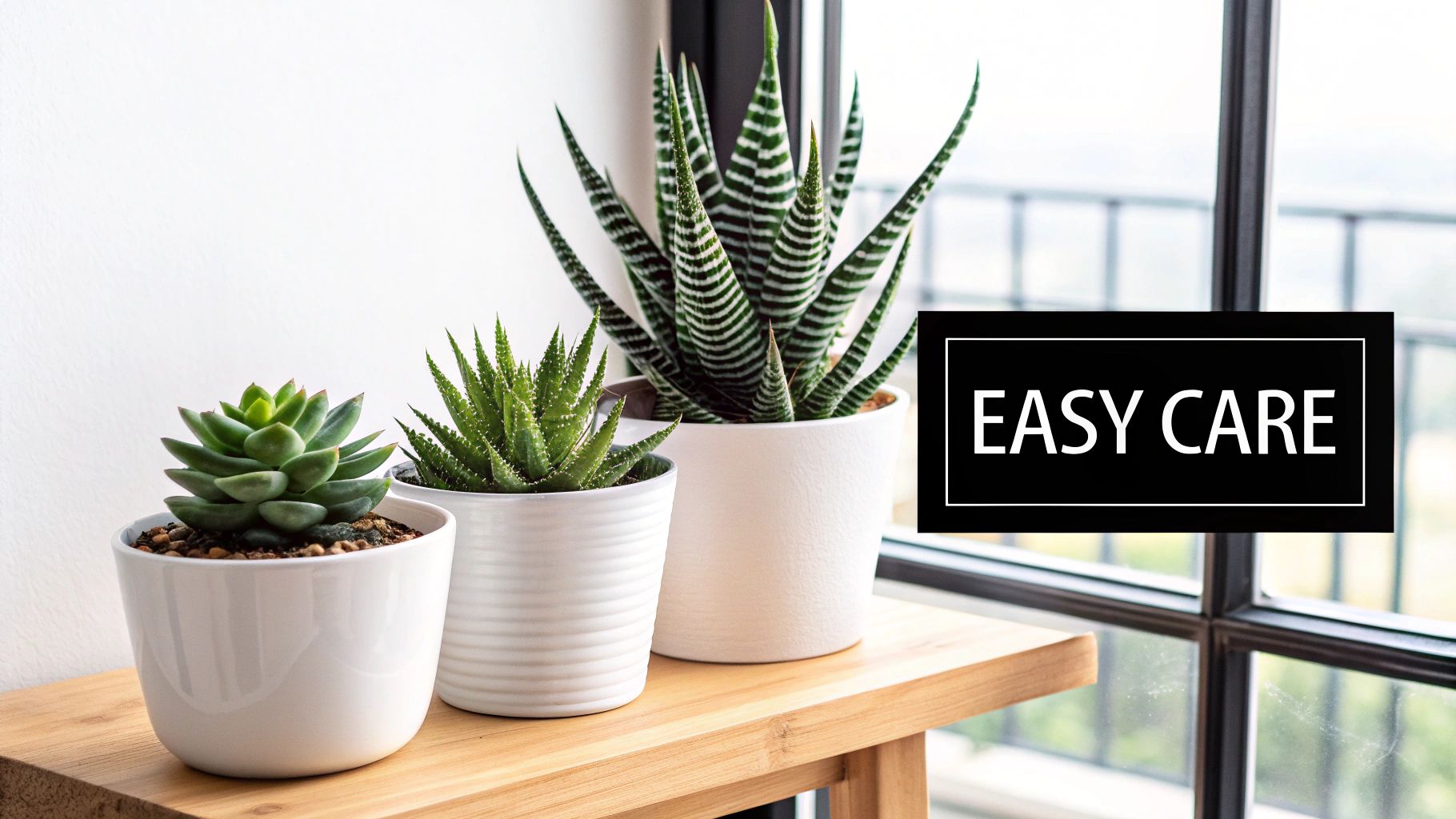
Choosing one of these low-light tolerant varieties opens up a world of possibilities. Suddenly, you can bring a touch of green to virtually any room, not just the ones blessed with perfect, sunny windows.
Top Performers in Lower Light
Let's meet a couple of the undisputed champions of low-light living. These plants aren't just getting by in dimmer conditions; they are genuinely thriving, which makes them my go-to recommendations for those tricky, darker spots in a house.
The Snake Plant (Dracaena trifasciata) is an absolute superstar. We already touched on it in the easy-care section, but its incredible tolerance for low light is worth a second mention. It's so efficient at photosynthesis that it can make do with very little light, making it a fantastic choice for hallways, bedrooms, and even bathrooms. If you're decorating a darker bathroom, you might find some great ideas in our guide on the best plants for a low-light bathroom.
Another one of my favorites is the ZZ Plant (Zamioculcas zamiifolia). This plant is so flawless it almost looks fake, with its waxy, deep green leaves. The ZZ Plant stores water in underground rhizomes (think of them like little potatoes), which makes it incredibly drought-tolerant. It's famously happy in spots where most other plants would give up.
Expert Tip: The biggest challenge for succulents in low light isn't actually the light—it's the water. Soil takes forever to dry out in a shady spot. You absolutely have to adjust your watering routine and wait until the soil is bone dry, or you risk root rot.
How to Help Your Low Light Succulents Succeed
Even the toughest low-light plants appreciate a little help to look their best. Without enough light, they can start to stretch out and look "leggy." This process is called etiolation, and it's basically the plant desperately reaching for a light source, getting pale and weak in the process.
Here are a few simple tricks to keep your low-light succulents compact, healthy, and happy:
- Rotate Regularly: I tell everyone to give their plants a quarter turn every week. It's a simple habit that encourages even growth and stops the plant from leaning awkwardly toward the nearest window.
- Keep Them Clean: Dust is the enemy of photosynthesis. It builds up on leaves and blocks what little light is available. A quick wipe-down with a damp cloth once a month makes a huge difference.
- Water Sparingly: This is the golden rule, and I can't say it enough. Stick your finger deep into the soil to check for moisture. In a low-light environment, you might only need to water once a month or even less, especially in winter.
Colorful and Unique Succulents for Living Decor
Some succulents are more than just green houseplants; they're living sculptures. These varieties are prized for their incredible colors, textures, and unusual shapes that can genuinely elevate a room's entire feel. I like to think of them less as plants and more as dynamic art pieces that subtly shift with the light and seasons.
Using these unique succulents as statement pieces is a fantastic way to inject personality into your home. Their striking forms naturally draw the eye, creating a focal point on a bookshelf, coffee table, or sunny windowsill. Bringing succulents indoors isn't just about aesthetics; it also ties into greener living by improving air quality. If you're curious about that, it's worth exploring the principles of sustainable interior design for a healthier home.
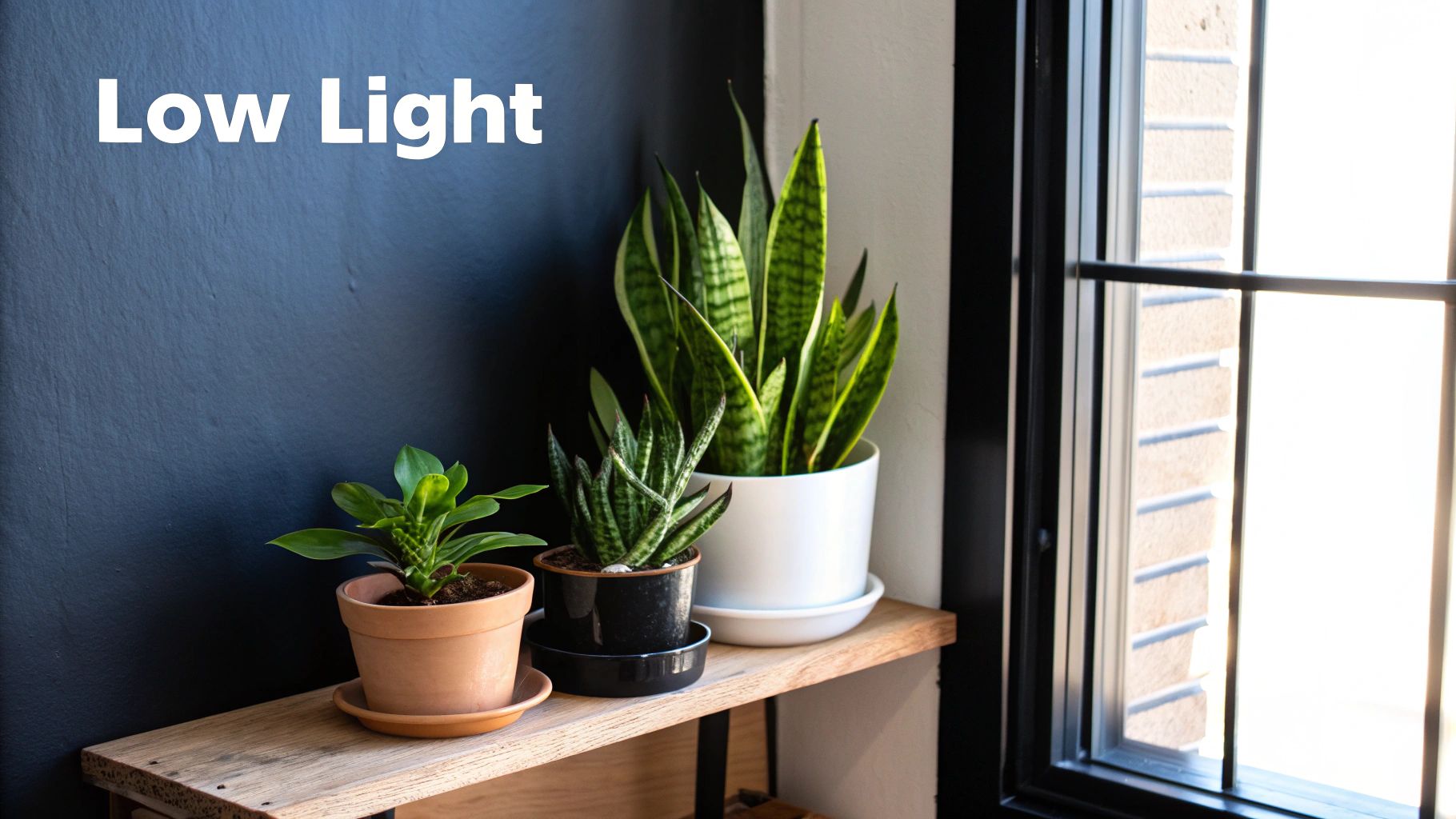
Eye-Catching Rosettes and Cascading Vines
The Echeveria genus is a perfect example of nature’s artistry. These succulents form stunning, flower-like rosettes that come in an absolute rainbow of colors—from pastel pinks and blues to deep, moody purples and vibrant reds. Their elegant symmetry makes them a long-time favorite for both designers and serious collectors.
If you're looking for a different kind of visual drama, trailing succulents are the way to go. These are perfect for hanging baskets or perching on high shelves where their foliage can spill over the edge. They add a sense of movement and lushness that works wonders to soften the hard lines of furniture and walls.
Two of the most popular trailing varieties have to be:
- String of Pearls (Senecio rowleyanus): This whimsical plant has long, delicate stems covered in tiny, bead-like leaves. It truly looks like a pearl necklace spilling from its pot and always gets people talking.
- Burro’s Tail (Sedum morganianum): Famous for its thick, braided stems that are packed with plump, overlapping leaves, this succulent has a wonderfully dense and textural look.
A little insider tip: the secret to getting those brilliant colors is something we call "sun stress." It sounds bad, but it’s not harmful! It's just the plant's natural reaction to bright light, which encourages it to produce its most vibrant pigments. Nailing that perfect light exposure is key.
Maintaining Their Stunning Colors
While incredibly beautiful, these colorful succulents often need a bit more attention to their environment to keep them looking so striking. The intensity of their color is directly linked to how much light they get. If you don't give them enough, you'll see those brilliant hues fade back to a plain green.
To keep them at their best, find a spot that gets at least 4-6 hours of bright, indirect sunlight every day. A south or west-facing window is usually the sweet spot. If you notice your Echeveria’s colors looking a little dull, that’s your plant telling you it needs more light. By managing their sun exposure, you can ensure these living sculptures stay the vibrant centerpiece of your indoor garden.
Getting to Know Your Indoor Succulents: The Essentials
To keep your indoor succulents happy, you have to get inside their heads a little bit. Forget everything you know about traditional houseplants. These guys have spent millennia evolving to survive in some of the toughest, driest places on earth, and their care needs reflect that. The key isn't a strict schedule; it's learning to read the subtle signs your plant is giving you.
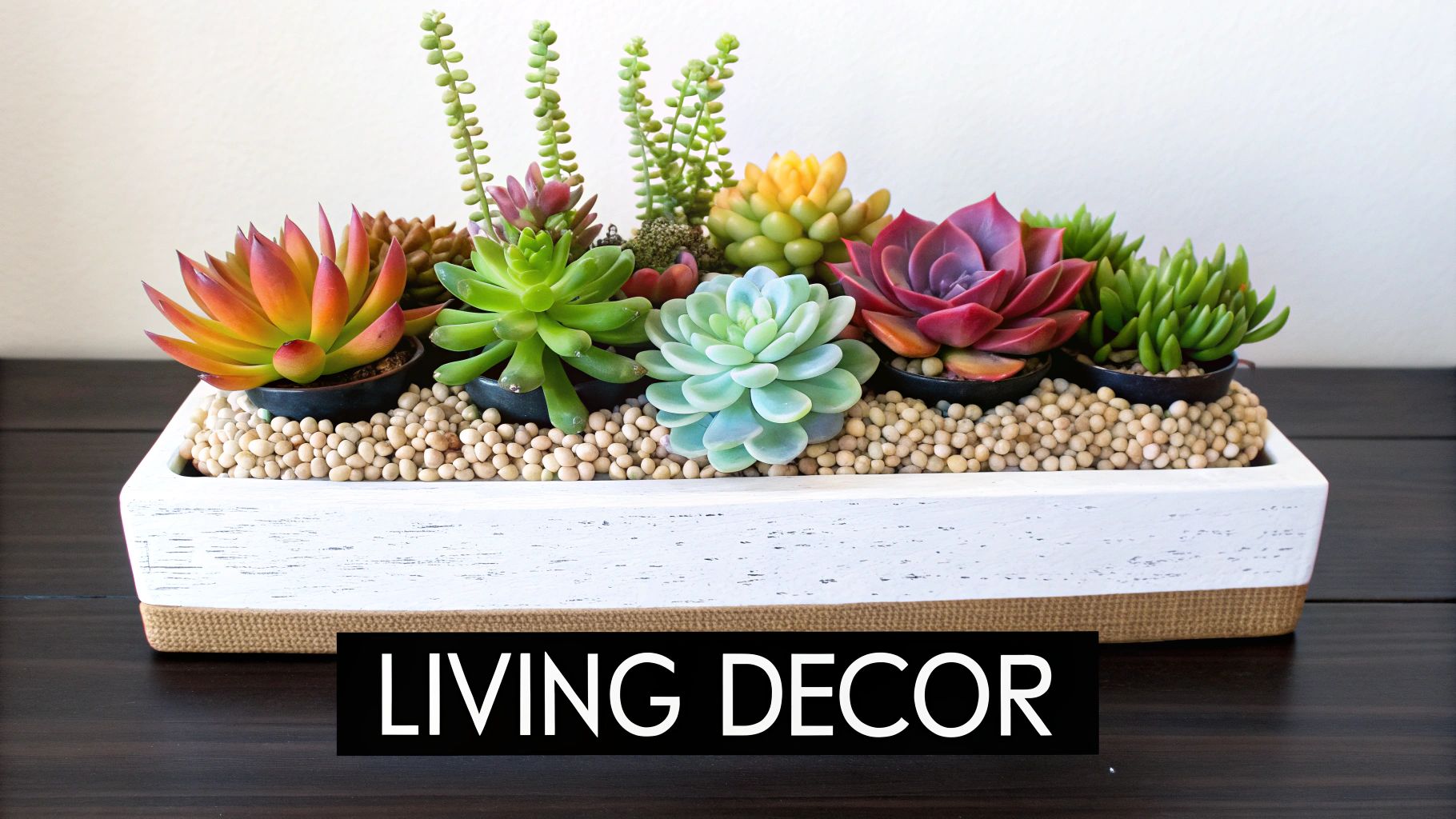
It really just boils down to three core things: how you water, where you put them, and what they're planted in. Nail these, and you'll have a home where your succulents don't just hang on—they truly thrive.
H3: The Golden Rule of Watering
If there's one thing that sends new succulent owners into a panic, it's watering. The biggest mistake, by far, is killing them with kindness. Too much water is the fast track to root rot, and once that sets in, it’s often game over.
The best way to water is the "soak and dry" method. It's designed to copy the rare, heavy rains of their native desert homes. When it’s time to water, give the soil a thorough drenching until you see water running out of the drainage hole. Then—and this is the critical part—let that soil dry out completely. Bone dry. Don't even think about watering again until it is.
Think of a succulent's roots like lungs. They need to breathe. When soil is constantly wet, it suffocates the roots, leading to decay. Letting the soil dry completely gives them the oxygen they need to stay healthy and strong.
For a deeper dive into watering techniques and other care tips, check out our complete succulent plant care guide.
H3: Let There Be Light (The Right Kind)
For a succulent, light is food. While some can get by in lower light, most of them crave bright, indirect sunlight to really flourish. But what does that actually mean inside your house?
- Bright Indirect Light: This is the sweet spot for many succulents. Picture the light a few feet back from a sunny window, or right next to a window that never gets hit with direct sunbeams (like a north-facing one). It's bright enough to read by without flipping on a lamp.
- Direct Sun: This is when the sun's rays are hitting the leaves head-on. A clear south or west-facing window is perfect for this. The real sun-worshippers need this intensity to show off their most stunning, vibrant colors.
If your succulent isn't getting enough light, it'll tell you. The most common sign is etiolation—when the plant starts stretching out and looking pale and "leggy." It's literally reaching for a light source. To keep things compact and even, give your plants a little quarter-turn every week.
H3: The Unsung Hero: The Right Soil
You can get the water and light perfect, but if your soil is wrong, you're fighting a losing battle. Regular old potting soil is a death sentence for succulents because it's designed to hold onto moisture. Succulents need the exact opposite. Their roots demand a gritty, fast-draining mix that won't leave them sitting in a puddle.
You can find specialty cactus and succulent soil mixes at most garden centers, or you can easily whip up your own. The goal is to create a blend that water just rushes right through. Here’s a super simple and effective recipe:
- Two parts standard potting soil
- One part perlite or pumice (for airflow)
- One part coarse sand or fine gravel (for drainage)
This mix makes sure that even after a good "soak," the soil won't stay soggy for long. It's the foundation for healthy roots and a happy plant.
Indoor Succulent Troubleshooting Guide
Even with the best care, you might run into a few bumps. Don't worry—most common succulent problems are easy to diagnose and fix. Here's a quick guide to help you figure out what your plant is trying to tell you.
| Symptom | Likely Cause | How to Fix It |
|---|---|---|
| Mushy, Yellowing, or Translucent Leaves | Overwatering | Stop watering immediately. Allow the soil to dry out completely. If rot is severe, repot in fresh, dry soil after removing any dead roots. |
| Wrinkled or Shriveling Leaves | Underwatering | Time for a good soak! Water thoroughly until it drains from the bottom, then let it dry out before the next watering. |
| Stretching or "Leggy" Growth | Not enough light | Move your plant to a brighter location with more indirect or direct sunlight, depending on the species. Rotate it weekly. |
| Brown or White Scorch Marks on Leaves | Sunburn | The plant was moved into direct sun too quickly. Move it to a spot with bright, indirect light to recover. Acclimate it to direct sun slowly. |
| Leaves Dropping Off Easily | Overwatering or underwatering | Check the soil moisture. If bone dry, it's thirsty. If damp, it's overwatered. Adjust your watering routine accordingly. |
| White, Cotton-Like Spots | Mealybugs | Isolate the plant. Use a cotton swab dipped in 70% rubbing alcohol to dab and remove the pests. For larger infestations, use insecticidal soap. |
Remember, observation is your best tool. A quick daily check-in can help you catch these issues early and get your succulent back on the path to good health.
Your Top Questions About Indoor Succulents, Answered
https://www.youtube.com/embed/5Ny_zHgCrP8
Even when you think you've got the hang of it, succulents can throw you a curveball. It’s totally normal to have questions pop up along the way. Think of this as a chat with a seasoned grower, where we’ll tackle some of the most common head-scratchers I hear all the time.
How Do I Know When It's Time to Water My Succulent?
This is, without a doubt, the question I get asked the most. My answer is always the same: forget the calendar and get to know your soil. The easiest and most reliable way to check is to stick your finger about an inch deep into the pot.
If it feels bone dry, go ahead and water. If you feel any dampness at all, hold off for a few more days. It’s that simple. Succulents are desert plants, after all, and they’re far happier being a little thirsty than they are sitting in a puddle. Overwatering is the number one killer of these plants because it suffocates the roots and leads to rot.
Another good clue is to look at the leaves. If they're starting to look a little wrinkled or feel soft, the plant has used up its water stores and is telling you it's ready for a drink.
What's the Best Kind of Pot for Indoor Succulents?
The single most important thing to look for in a pot is a drainage hole. I can't stress this enough—it's completely non-negotiable. Without a way for extra water to escape, the roots will be trapped in soggy soil, which is a one-way ticket to root rot.
The material of the pot makes a difference, too. Here’s how they stack up:
- Terracotta (Unglazed Clay): This is the gold standard for succulents. The clay is porous, which means it breathes. Water evaporates through the sides of the pot, helping the soil dry out faster and letting air get to the roots.
- Glazed Ceramic or Plastic: These look great, but they don't breathe. They hold moisture in for much longer, which means you have to be extra careful not to overdo it with the watering can. They can work, but they leave less room for error.
If you’ve fallen hard for a beautiful pot that has no drainage, all is not lost. Just use it as a decorative "cachepot." Keep your succulent in its simple nursery pot (with holes!) and just slip that inside the prettier one.
Help! Why Are My Succulent's Leaves Falling Off?
Seeing leaves drop can be a bit scary, but your plant is just trying to tell you something. Nine times out of ten, the culprit is overwatering. When a succulent gets too much water, its leaves swell up until their cell walls literally burst. They become mushy and fragile, falling off at the slightest nudge.
If this is happening, feel the soil right away. If it’s wet, let it dry out completely before you even think about watering again. On rare occasions, leaves dropping can be a sign of extreme underwatering. In that case, the plant is sacrificing its oldest, lowest leaves to conserve resources. You'll know this is the cause if the dropped leaves look dried up and shriveled, not mushy and swollen.
Can Succulents Survive in a Room With No Windows?
Honestly, this is a tough one. While some succulents are incredibly tolerant of low light—I'm looking at you, Snake Plant and ZZ Plant—a room with zero natural light is pushing it. All plants need some light to photosynthesize and create energy to live.
In a windowless room, a succulent will start to weaken. It will lose its vibrant color and begin to stretch out, looking long and spindly as it desperately searches for a light source. This process is called etiolation. If you're set on having a plant in a dark space, your only real option is to supplement with a full-spectrum grow light for at least 8-10 hours a day to give it what it needs.
Ready to find the perfect plant to match your home and lifestyle? At The Cactus Outlet, we offer a vast collection of healthy, beautiful, and unique succulents and cacti, delivered right to your door. Explore our selection and start your indoor garden today at https://www.cactusoutlet.com.

